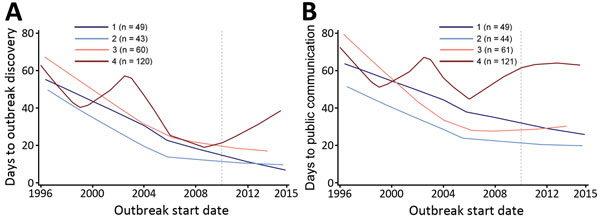Volume 22, Number 10—October 2016
Online Report
Global Capacity for Emerging Infectious Disease Detection, 1996–2014
Figure 3

Figure 3. Loess curves of time to A) outbreak discovery and B) public communication, by quartile of change in Human Development Index rank, in a study assessing global capacity for emerging infectious disease detection, 1996–2014. Dashed line marks the beginning of the 5-year period of this study.
Page created: September 27, 2016
Page updated: September 27, 2016
Page reviewed: September 27, 2016
The conclusions, findings, and opinions expressed by authors contributing to this journal do not necessarily reflect the official position of the U.S. Department of Health and Human Services, the Public Health Service, the Centers for Disease Control and Prevention, or the authors' affiliated institutions. Use of trade names is for identification only and does not imply endorsement by any of the groups named above.